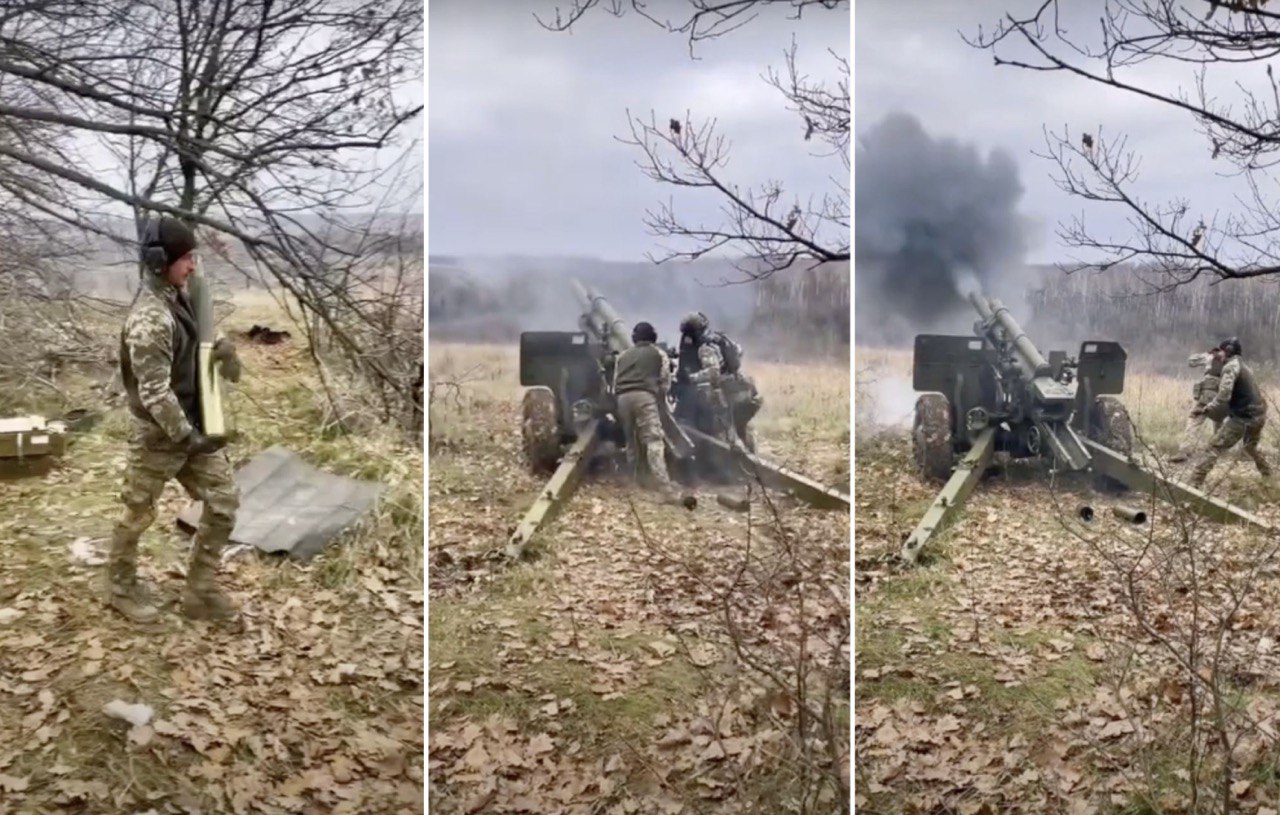
WW2 Howitzers Being Used in Ukraine
M101 – A Battle Winner
M101 howitzers are a long-range weapon that fires 105 mm high explosive, semi-fixed ammunition. Additionally, the artillery piece comes with an effective range of 12,330 yards – approximately 11 kilometres.
Initially, the U.S. Army developed the M101 howitzer in 1941. The artillery quickly gained popularity and became the standard U.S. light field howitzer in World War Two. Consequently, the artillery actively served in the European and Pacific Theatres and were used on self propelled guns.
In World War Two, the M101 would help turn the tide of war in favour of the Allies. Still, eight decades later, the M101 remains a deadly machine in the hands of an experienced gunner. Coupled with advanced drones, the vintage howitzers transform into a fearsome enemy.
 A Ukrainian M101 in action (PHOTO:UKRAINIAN DEFENSE MINISTRY)
A Ukrainian M101 in action (PHOTO:UKRAINIAN DEFENSE MINISTRY)
During World War 2, the U.S. Army Ordnance Department studied numerous German howitzers. Then, studying German machinery, the U.S. Army upgraded all 75 mm gun-howitzers to 105 mm. The experiment became a roaring success. The high-calibre weapon displayed an outstanding performance and quickly gained a reputation for its accuracy and power.
Read More: Man Steals Rocket From Ukrainian Battlefield, it Blows up in his Car
Lithuanian M101 Howitzers in Ukraine
Recent footage shows a 105 mm howitzer in action against the Russian forces. In 2002, Lithuania towed 54 cannons from Denmark. However, the country is now replacing them with advanced German and French 155 mm howitzers. In the ongoing replacement, Ukraine borrowed an undisclosed number of the redundant M101s from Lithuania.
Lituania shipped the first batch of its M101s in September. In addition to the vintage artillery, many iconic weapons – old and new – are replacing the ex-Soviet guns in Ukraine.
 A Lithuanian M101 howitzer being loaded onto a lorry destined for Ukraine.
A Lithuanian M101 howitzer being loaded onto a lorry destined for Ukraine.Although the M101 is an old artillery piece, it works perfectly fine using the standard NATO shells. As a result, the United States and the United Kingdom have supplied thousands of 105 mm standard shells to Ukraine.
Read More: Rare WWII Valentine DD Tank Damaged
During World War Two, an M101 required a human spotter to call in targets and identify threats. However, Ukrainian forces have largely replaced human spotters with drones, making the howitzers more responsive and accurate than ever before. With an effective range that is two miles greater than Ukraine’s ex-Soviet 100-millimeter guns, the M101 has become an essential piece of equipment for the country at war.
Military Assistance by the West
According to U.S. Defence officials, western countries have donated 350 howitzers to the Ukraine. However, one-third of these howitzers are expected to be out of action at any given time.
Swapping out a howitzer’s barrel is a challenging task beyond the capability of on-field soldiers. Therefore, the Pentagon’s European Command has set up a Howitzer Repair Facility in Poland.
Lt. Commander Daniel Day of the U.S. Army has expressed solidarity with Ukraine. He mentioned, “with every capability, we give to Ukraine, and those our allies and partners provide, we work to ensure that they have the right maintenance and sustainment packages to support those capabilities over time.”
The Pentagon has also sent 142 M777 howitzers to Ukraine, enough cannons to outmatch about eight battalions. Armed with Western support, Ukrainian troops are going in hot against the Russians with volleys of 155 mm shells.
News
The Hanging Temple: China’s 1,500-Year-Old Cliffside Marvel of Faith and Engineering
The Hanging Temple: China’s 1,500-Year-Old Cliffside Marvel of Faith and Engineering Perched precariously on the cliffs of Mount Heng in Shanxi Province, China, the Hanging Temple, also known as Xuankong Temple, Hengshan Hanging Temple, or Hanging Monastery, is an architectural…
The Willendorf Venus: A 30,000-Year-Old Masterpiece Reveals Astonishing Secrets
The Willendorf Venus: A 30,000-Year-Old Masterpiece Reveals Astonishing Secrets The “Willendorf Venus” stands as one of the most revered archaeological treasures from the Upper Paleolithic era. Discovered in 1908 by scientist Johann Veran near Willendorf, Austria, this small yet profound…
Unveiling the Maya: Hallucinogens and Rituals Beneath the Yucatán Ball Courts
Unveiling the Maya: Hallucinogens and Rituals Beneath the Yucatán Ball Courts New archaeological research has uncovered intriguing insights into the ritual practices of the ancient Maya civilization. The focus of this study is a ceremonial offering found beneath the sediment…
Uncovering the Oldest Agricultural Machine: The Threshing Sledge’s Neolithic Origins
Uncovering the Oldest Agricultural Machine: The Threshing Sledge’s Neolithic Origins The history of agricultural innovation is a fascinating journey that spans thousands of years, and one of the earliest known agricultural machines is the threshing sledge. Recently, a groundbreaking study…
Nara’s Ancient Sword: A 1,600-Year-Old Protector Against Evil Spirits
Nara’s Ancient Sword: A 1,600-Year-Old Protector Against Evil Spirits In a remarkable discovery that has captured the attention of archaeologists and historians alike, a 7.5-foot-long iron sword was unearthed from a 1,600-year-old burial mound in Nara, Japan. This oversized weapon,…
The Inflatable Plane, Dropped Behind the Lines for Downed Pilots
Experimental The Inflatable Plane, Dropped Behind the Lines for Downed Pilots The Inflatoplane from Goodyear was an unconventional aircraft developed by the Goodyear Aircraft Company, a branch of the renowned Goodyear Tire and Rubber Company, also famed for the Goodyear…
End of content
No more pages to load











